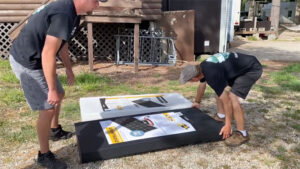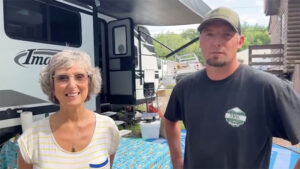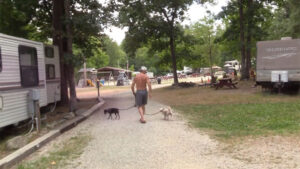SHOW 2022-24
Hi, this is Michelle Fontaine for “RVing Today TV.” I’m up on my RV roof, admiring my brand-new Go Power 190-watt solar panels. That’s what today’s story is about, the research, planning, and installation of this amazing solar system by Go Power. So, let’s start with a conversation I had with Jake at Go Power.
Jake handles customer service calls at Go Power, and it’s so nice to be able to get a human being on the phone for some really nice, clear answers. I used your tools on gpelectric.com. Excellent solar calculator, lots of tools there to help us out, and I got a good feel for how I use dry camping, and my personal case is mostly fall-winter because I’m in Arizona, and that’s the perfect time to go dry camping in the deserts we have around here. So, two, three days at a time is my style of dry camping, and the last time I went out, honestly, I was watching the little control panel, and the green lights will tell ya how much you’ve got left. My family and I were playing dominoes. I had to watch that green power light ’cause I don’t want the lights to go out, so– Jake: Oh, no. Michelle: So, I came back from there, and I said, “I’ve gotta contact our partners at Go Power and see how I can upgrade what I currently have. I have a 100-amp lithium battery, a 2,000-watt inverter and I have a portable plug on the side, 130-watt portable panel setup.
I’d like to actually sit and watch a movie from my DVD and TV, so that’s, like, maybe three hours on the DVD player, three hours on the TV. I’d love to use my Keurig coffee maker. And because I film for “RVing Today TV,” I need to be able to charge a camera battery and eight AA batteries whenever I need to.
 Jake: For your particular needs, I would say Solar Elite Kit is 380 watts of solar, that is, two 190-watt panels, a 30-amp solar controller to regulate that power, a 2,000-watt IC unit– an that’s an inverter charger– that’s gonna produce 2,000 watts of AC power, as well as a 100-amp battery charger built in. You also get the DC-install kit and all the cabling to install this system on your coach.
Jake: For your particular needs, I would say Solar Elite Kit is 380 watts of solar, that is, two 190-watt panels, a 30-amp solar controller to regulate that power, a 2,000-watt IC unit– an that’s an inverter charger– that’s gonna produce 2,000 watts of AC power, as well as a 100-amp battery charger built in. You also get the DC-install kit and all the cabling to install this system on your coach.
Michelle: Now we knew what the Go Power project looked like. I headed to my Massachusetts summer base, and the Go Power equipment was delivered. Next, we needed to identify the mobile tech who was going to install it. Our friend, Bob Zagami, who is the executive director of the New England RV Dealers Association, recommended Ryan Hadley of TRIC RV Mobile Systems. Ryan Hadley: When this is done she’ll be able to run all of her appliances except for the air-conditioner inside the unit. The air-conditioner is just too much of a draw. It’ll kill the batteries real quick. Other than that, everything will be– all her 110 stuff will be able to run while she’s off the grid.
Ryan Hadley: When this is done she’ll be able to run all of her appliances except for the air-conditioner inside the unit. The air-conditioner is just too much of a draw. It’ll kill the batteries real quick. Other than that, everything will be– all her 110 stuff will be able to run while she’s off the grid.
We go to campgrounds, fix your camper. We go to your house if you don’t wanna bring it to the dealership, don’t wanna wait a day and bring it in there and tow it and everything. We come right to you. So we offer all of our services, including all the appliances, maintenance, wheel bearings, everything on a camper. The only thing we don’t do is the engine and drivetrain side.
Michelle: Now that our Go Power solar-install project is underway, let’s take a look around King’s Family Campground, the place I’m calling home this summer and fall. King’s Family Campground is located in Sutton, Massachusetts, in Worcester County, on Manchaug Pond. It has 1,200 feet of waterfront with a 20-slip power-boat marina and a small fishing dock. Most sites are seasonal, but there are a number of transient sites as well, and these sites are larger than sites at most campgrounds. Many of the happy campers I’ve met have been here for many years.
 Michelle: We’re visiting with Kara and Bill. Kara and Bill are seasonal campers, so I think the nice thing about a seasonal situation is you really get to know everybody, and it is a community. You can learn more about this campground at KingsFamilyCampground.com. And now let’s get back to our installation.
Michelle: We’re visiting with Kara and Bill. Kara and Bill are seasonal campers, so I think the nice thing about a seasonal situation is you really get to know everybody, and it is a community. You can learn more about this campground at KingsFamilyCampground.com. And now let’s get back to our installation.
Ryan: She’s gonna have a standalone inverter converter, two solar panels on the roof, hardwiring the inverter right into her 30-amp breaker so that she’ll run all the appliances right off the inverter.
Michelle: And you got help earlier, someone from the Go Power customer service. They were pretty good, huh? Ryan: Yup, they answered a few questions we had about which way we decided to wire this one, and they– Go Power, they answered the phone right away, and they said, “If you have any = questions or concerns, feel free to call us,” so they were definitely a great help.
Michelle: So that’s how the installation happened. Now that I’m very comfortably able to go off grid,
‘ll be creating some stories in the Arizona deserts this winter, so stay tuned. Michelle Fontaine for “RVing Today TV.”



